Cover Story
Graphicstudio: For the Love of Art
USF's innovative Graphicstudio is recognized as the nation's leading university-based art research atelier.
| USF News
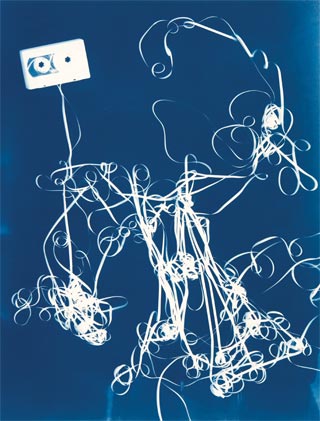
"Untitled" is one of a series of unique cyanotypes produced at Graphicstudio by Christian Marclay, using cassettes and unfurled tapes. Marclay was recently named one of "The 10 Most Important Artists of Today" by Newsweek (Daily Beast).
Photo courtesy of USF Graphicstudio
The once familiar ribbons dance across a striking blue background — music cassette tapes unspooled, strewn and tangled.
The prints are part of an extraordinary collection of Prussian blue cyanotypes created by Christian Marclay in collaboration with USF's Graphicstudio. Over the course of two years, Marclay made repeated visits to the university-based atelier, working with the studio's master printers to complete the innovative project. He even refers to Graphicstudio as "my studio away from my studio."
Since 1968, emerging and world-renowned contemporary artists, including Robert Rauschenberg, James Rosenquist, Roy Lichtenstein, Ed Ruscha, Mark Dion and Teresita Fernández, have worked in residence at Graphicstudio. The atelier provides artists the freedom to experiment with new materials and processes while tapping into the university's vast resources.
"Graphicstudio is an innovative artist residency program recognized as the leading university-based art research atelier in the United States," says Margaret A. Miller, professor and director of the Institute for Research in Art, the umbrella organization for Graphicstudio, the Contemporary Art Museum and the Public Art program at USF. "We are advancing the research of artists in a collaborative environment."
At the Tampa campus atelier, hand-picked resident artists are matched with exceptionally talented faculty and staff who often work around the clock to pursue new directions and ideas to advance their practice. Their collaborations have resulted in new processes and treatments of traditional print-making methods, such as a process for printing encaustic waxes, called "waxtype," and enhancements to the 19th century photogravure process to allow for the hand-printing of unusually large images and four-color separations.
Graphicstudio first used the cyanotype process with Rauschenberg in the early 1970s. Unlike silver-based photographs, cyanotypes use a mixture of light-sensitive iron compounds and are often called "blueprints" because of their distinctive Prussian blue color. Marclay wanted to explore the cyanotype technique and extend its scale and complexity with the expertise of Graphicstudio.
Working with the atelier's team of printers, Marclay created each cyanotype by placing music cassettes purchased from local thrift shops and reels of unspooled tape directly onto photo-sensitive paper and then exposing it to light. The team's research into the limitations and possibilities of the cyanotype method helped steer Marclay's dramatic successes.
"What distinguishes us from a commercial press is our ability to call in an entire community of researchers to support a project an artist might want to do," says Miller. "Our artists have the ability to walk into a scientist's laboratory and have a conversation."
When contemporary artist Keith Edmier wanted the perfect model of a heart to create his "Adonais" sculpture of two human hearts — one in a contracted state and one in a state of expansion — he used data derived from MRI scans made on the USF campus, and developed a rapid prototype based on a model of the human heart from USF Health. To make his "Cycas Revoluta Bulbil," Edmier worked with Graphicstudio fabricators and researchers in the Department of Geology to develop new techniques for pouring molten basalt lava.
But not every project comes to fruition.
"Sometimes it's magical; sometimes it's so hard to get it," Miller says. "Maybe we don't get it on the artist's first visit. Sometimes we let six months, a year go by before we figure out where to go next. It's not a formula."
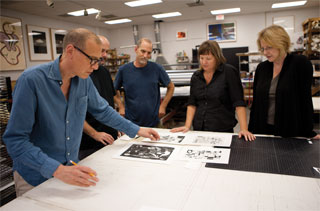
Christian Marclay signing etchings with the research team: Tim Baker, Tom Pruitt, Sarah Howard and director Margaret Miller.
Photo by Will Lytch | USF Graphicstudio
While the collaboration serves to advance each artist's practice, students and faculty as well derive significant benefits from their exchanges with visiting artists, according to Miller.
"When we choose an artist, we consider that artist's ability to participate in and contribute to campus in a profound and interdisciplinary way."
And to stimulate discussion.
French-American sculptor Louise Bourgeois' work involves spiders that inhabit and dominate great public spaces; American folk artist Trenton Doyle Hancock's three-dimensional, glow-in-the-dark wallpaper tells a fantastical story about half-animal, half-plant creatures preyed upon by evil beings called vegans; Allan McCollum's "Shapes" project speaks to issues of representation, categorization, symbolic systems, and questions of uniqueness, originality and mass production.
"On a weekly basis as many as ten classes come through Graphicstudio," Miller says. Many of the studio's projects are inspired by literary works, historical events, and socially and politically-charged issues of the day.
"There are so many pathways to experience what we are doing."
From its founding by Distinguished Professor Emeritus Donald J. Saff in 1968, Graphicstudio has earned widespread popular and critical acclaim. In 1990, an archive of Graphicstudio's publications was established at the National Gallery of Art in Washington, D.C., and later became the subject for a comprehensive exhibition and catalogue.
Over the years, Graphicstudio's editions have been acquired by collectors from around the world and leading museums, including the Museum of Modern Art, the Whitney Museum of American Art, the New York Public Library and the John and Mable Ringling Museum of Art in Sarasota.
"Often we invite young, emerging artists with promise. We are fortunate when their careers develop," Miller says. "And we are always pleased when something we do gets national attention."
To date, about 150 artists have produced some 1,500 limited edition prints and sculpture multiples at the studio – many works considered to be at the forefront of contemporary art. Under an arrangement entered into with resident artists, USF retains 50 percent of the proceeds of works produced at the studio and sold to collectors, galleries, museums and artist's dealers.
Carrying out the studio's mission is a costly undertaking. Less than 35 percent of Graphicstudio's funding comes from the university and public sources. A Subscription Program, which allows individual, corporate and institutional collectors to acquire distinctive prints and sculpture multiples, has been a vital component in ensuring the program's continued success. So, too, has the studio's annual one-day benefit sale.
In October, about 250 art patrons meandered through the studio for the benefit sale, perusing and purchasing innovative works by Los Carpinteros, Chuck Close, Iva Gueroguieva, Alex Katz, Robert Mapplethorpe, Vik Muniz, Robert Rauschenberg, James Rosenquist, Ed Ruscha, Alyson Shotz, Janaina Tschäpe, and William Wegman, among many others.
"It takes the whole campus and an infusion of resources and talented people to make this work," says Miller. "This is a team endeavor."
Graphicstudio Artist Timeline
-
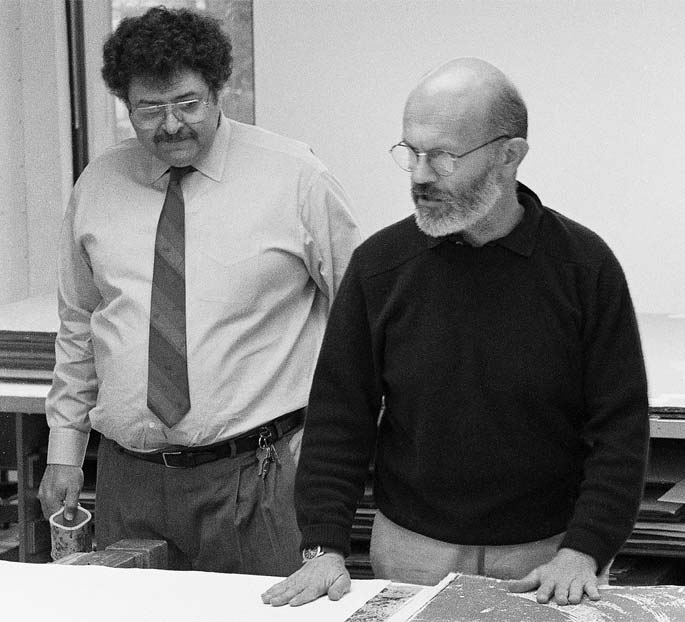
1960s
Donald J. Saff on left with artist Jim Dine. Graphicstudio was founded in 1968 by now Dean Emeritus Saff.
Photo courtesy of USF Graphicstudio
-

1970s
Artist James Rosenquist working on a large-scale lithograph. Rosenquist has continued to work at the studio since the early 70s.
Photo courtesy of USF Graphicstudio
-
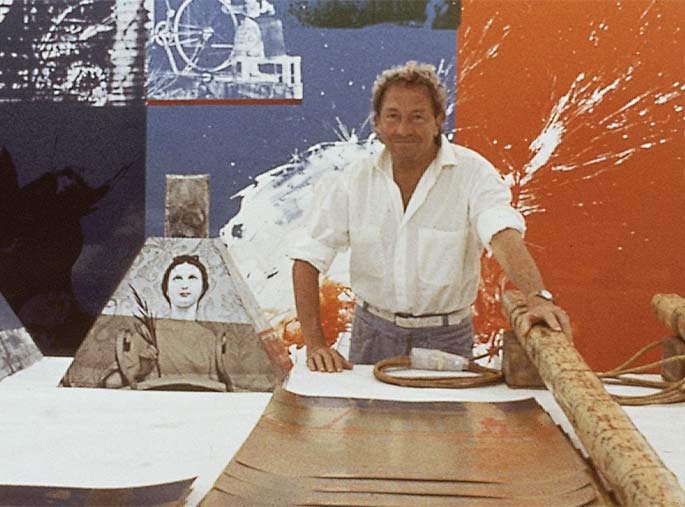
1980s
Robert Rauschenberg with sculpture multiples made in the 80s in connection with ROCI (Rauschenberg Overseas Cultural Interchange) directed by Saff.
Photo courtesy of USF Graphicstudio
-
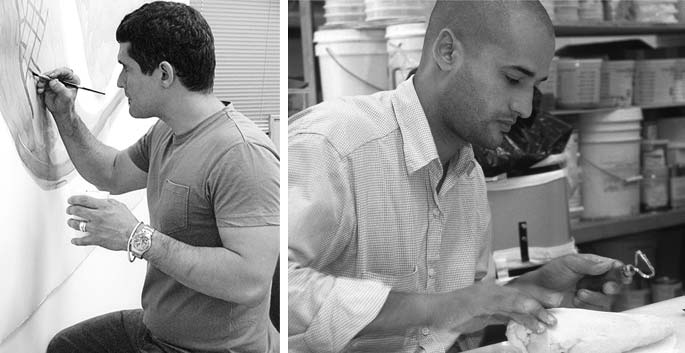
1990s
Cuban art collective Los Carpinteros (Marco Castillo and Dagoberto Rodríguez) working on projects. In the 90s, Noel Smith, Curator of Latin American and Caribbean Art, initiated exchanges with Latin American artists with a focus on Cuba.
Photo by Will Lytch | USF Graphicstudio
-
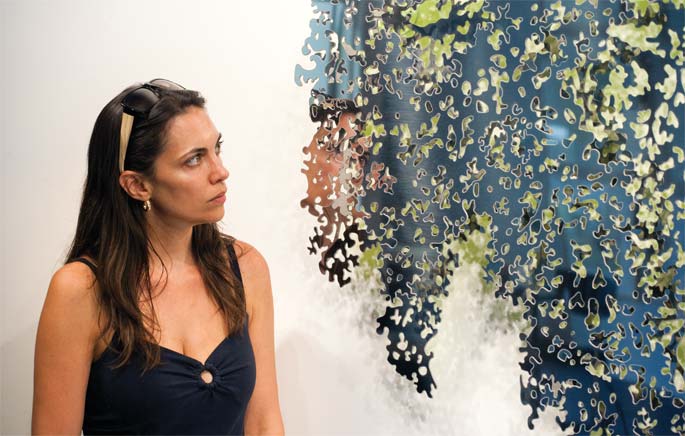
2000s
New York-based artist Teresita Fernández with "Apparition," a precision- cut polished stainless steel wall work with screened ink on back from 2007.
Photo by Will Lytch | USF Graphicstudio